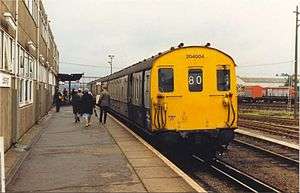British Rail Class 204
| British Rail Class 204 | |
|---|---|
|
204004 pictured on arrival at Eastleigh on 28 August 1986 | |
| In service | 1957–1987 |
| Scrapped | all by 1987 |
| Operator(s) | Southern Region of British Railways |
| Specifications | |
| Prime mover(s) | English Electric 4SRKT Mark II |
| Power output | 600 shp (450 kW) at 850 rpm |
| Track gauge | 4 ft 8 1⁄2 in (1,435 mm) |
The British Rail Class 204 designation has been used twice for two similar types of diesel-electric multiple units.
The original units, numbered in the range 1119-1122, were two-car versions of the Class 205 '3H' units, and were classified as 2H under the old system.
In 1979, BR decided to augment the two-car units to three-car formation. Three of the four units were reformed with the addition of centre trailers taken from 3H (Class 205) units, and thus were themselves reclassified as Class 205.
The fourth 2H unit, and the three former 3H units which had given up their trailers, were augmented by reusing the ex-2EPB driving trailers from redundant Class 206 units. The Class 204 designation was re-applied to these four newly formed units (which were also given the classification 3T under the old system). They were renumbered into the range 1401-1404. In 1986, the units were renumbered to 204001-004 to conform with the TOPS numbering system.
Technical details
Power car (one per set)
- Introduced: 1957
- Weight: 56 long tons (57 t; 63 short tons)
- Engine: English Electric 4-cylinder type 4SRKT Mark II of 600 bhp (450 kW) at 850 rpm
- Transmission: Diesel-electric, two English Electric type EE507 traction motors rated at 186 kW (249 hp) (250 hp or 190 kW) each.
- Maximum tractive effort: 12,500 lbf (56,000 N)
- Driving wheel diameter: 3 ft 6 in (1,067 mm)
- Coupling code: Standard 'Buckeye' (tightlock coupler?) compatible with contemporary class 20x and 4xx units.
- Train heating: Electric
Fleet details
| Key: | Reclassified | Reformed | Scrapped |
|---|---|---|---|
Original Class 204 (2H) Units
| Unit Number | DMBSO | DTCsoL | Disbanded[1] | Status |
|---|---|---|---|---|
| 1119 | 60118 | 60818 | 3/1980 | Reclassified as 3H (unit 1119) with addition of TSO 60653 |
| 1120 | 60119 | 60819 | 3/1980 | Reclassified as 3H (unit 1120) with addition of TSO 60652 |
| 1121 | 60120 | 60820 | 5/1974 | Reclassified as 3H (unit 1108) with addition of TSO 60657 |
| 1122 | 60121 | 60821 | 2/1980 | Converted to 3T unit 1402 with addition of DTSso 77508 |
Reformed Class 204 (3T) Units
| Unit Number | DMBSO | DTSso | DTCsoL | Withdrawn | Status | ||
|---|---|---|---|---|---|---|---|
| New | Old | Original | |||||
| 204001 | 1401 | 1108 * | 60107 | 77500 | 60807 | 8/1987 | Scrapped |
| 204002 | 1402 | 1122 | 60121 | 77508 | 60821 | 11/1987 | Scrapped |
| 204003 | 1403 | 1103 * | 60102 | 77507 | 60802 | 9/1987 | Scrapped |
| 204004 | 1404 | 1104 * | 60103 | 77503 | 60803 | 8/1987 | Scrapped |
* ex-Class 205
Preservation
Of the original 2H units, a single driving trailer has been preserved.
- 205008 (ex-1121) - DTCsoL 60820 - Hastings Diesels, currently at the Lavender Line.
None of the reformed 3T units are preserved.
References
- ↑ Disbanded Dates and Withdrawal Dates from H. Longworth, British Railways First Generation DMUs, Oxford Publishing Company 2011 ISBN 978-0-86093-612-1
